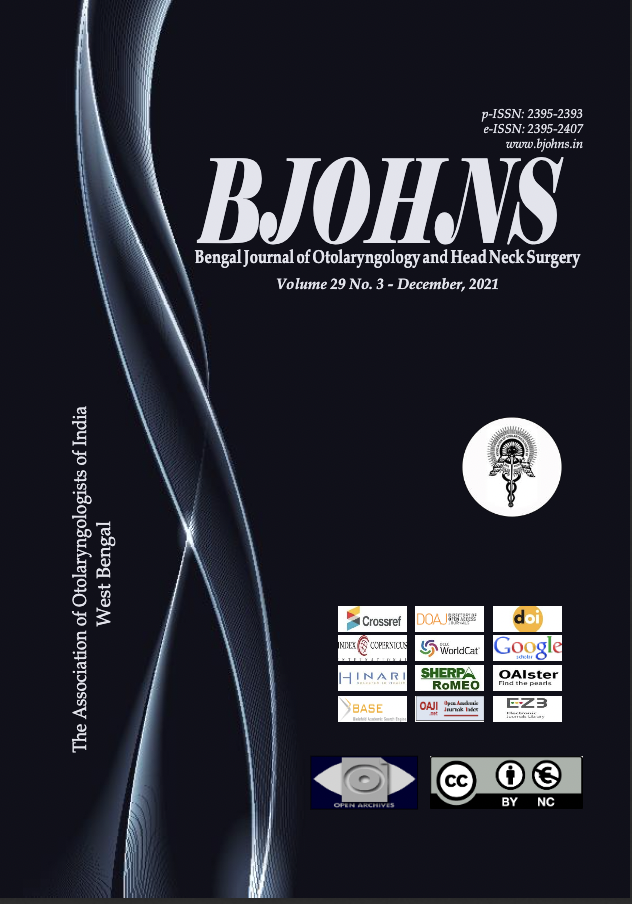New-Onset Ageusia among COVID-19 Patients- The Trend in the Indian Population
Main Article Content
Abstract
Introduction
The COVID-19 virus has already caused a pandemic and needs no fresh introduction. Many studies in western literature have described the prevalence of anosmia and ageusia as symptoms of COVID-19. However, to our knowledge, there is no study describing the trend of new onset ageusia amongst covid positive patients in the Indian population. The objective of this study is to analyze the trend of new onset ageusia in COVID-19 affected individuals in the Indian population.
Materials and Methods
This is a retrospective observational study conducted in a treatment facility set up in Eastern part of India. The data was collected from Sep 2020 to Dec 2020. The study included 422 patients who were laboratory confirmed COVID-19 positive cases. Clinical data was extracted from the medical records of the patients. All the patients were treated as inpatients. The data was collected by Critical care specialist and Physician. All patients were classified as asymptomatic and symptomatic. The presence or absence of new onset ageusia was documented and statistically analyzed.
Results
Of 422 cases studied, 401 (95.0%) were male and 21 (5.0%) were female with the mean age of 37.9 ± 8.3 years. 147 (34.8%) were symptomatic and 275 (65.2%) were asymptomatic with 18 % (76/422) patients having ageusia in the study population.
Conclusion
The prevalence of ageusia amongst covid positive patients in Indian population is lesser as compared to reports in the western literature. The cause of this difference in prevalence of ageusia in different ethnicities is unknown. Apparently healthy individuals with new onset ageusia should be considered as asymptomatic covid carriers and should be treated accordingly.
Article Details

This work is licensed under a Creative Commons Attribution-NonCommercial 4.0 International License.
References
Wang D, Hu B, Hu C, Zhu F, Liu X, Zhang J, et al. Clinical Characteristics of 138 Hospitalized Patients With 2019 Novel Coronavirus–Infected Pneumonia in Wuhan, China. JAMA. 2020; 323(11):1061
Li Q, Guan X, Wu P, Wang X, Zhou L, Tong Y, et al. Early Transmission Dynamics in Wuhan, China, of Novel Coronavirus–Infected Pneumonia. N Engl J Med. 2020; 382(13):1199-207
Covid-19 pandemic: Tracking the global coronavirus outbreak. BBC News [Internet]. 2020 Oct 21 [cited 2020 Oct 22]; Available from: https://www.bbc.com/news/world-51235105
Day M. Covid-19: four fifths of cases are asymptomatic, China figures indicate. BMJ [Internet]. 2020 Apr 2 [cited 2020 Oct 22];369. Available from: https://www.bmj.com/content/369/bmj.m1375
Lao WP, Imam SA, Nguyen SA. Anosmia, hyposmia, and dysgeusia as indicators for positive SARS-CoV-2 infection. World J Otorhinolaryngol-Head Neck Surg. 2020;
Wee LE, Chan YFZ, Teo NWY, Cherng BPZ, Thien SY, Wong HM, et al. The role of self-reported olfactory and gustatory dysfunction as a screening criterion for suspected COVID-19. Eur Arch Otorhinolaryngol. 2020;1-2
Mao L, Jin H, Wang M, Hu Y, Chen S, He Q, et al. Neurologic manifestations of hospitalized patients with coronavirus disease 2019 in Wuhan, China. JAMA Neurol. 2020;77(6):683-90
Xydakis MS, Dehgani-Mobaraki P, Holbrook EH, Geisthoff UW, Bauer C, Hautefort C, Herman P, Manley GT, Lyon DM, Hopkins C. Smell and taste dysfunction in patients with COVID-19. Lancet Infect Dis. 2020; 20(9):1015-6. doi: 10.1016/S1473-3099(20)30293-0
Xu H, Zhong L, Deng J, Peng J, Dan H, Zeng X, et al. High expression of ACE2 receptor of 2019-nCoV on the epithelial cells of oral mucosa. Int J Oral Sci. 2020 24;12(1):8.
Agyeman AA, Chin KL, Landersdorfer CB, Liew D, Ofori-Asenso R. Smell and Taste Dysfunction in Patients With COVID-19: A Systematic Review and Meta-analysis. Mayo Clin Proc. 2020; 95(8):1621-31
Moro E, Priori A, Beghi E, Helbok R, Campiglio L, Bassetti CL, et al. The international European Academy of Neurology survey on neurological symptoms in patients with COVID-19 infection. Eur J Neurol. 2020;27(9):1727-37
Organization WH. Laboratory testing for coronavirus disease 2019 (COVID-19) in suspected human cases: interim guidance, 2 March 2020. 2020 [cited 2020 Oct 20]; Available from: https://apps.who.int/iris/handle/10665/331329
Group ICS, Team CE & DM, Team CL, Team V. Laboratory surveillance for SARS-CoV-2 in India: Performance of testing & descriptive epidemiology of detected COVID-19, January 22 - April 30, 2020. Indian J Med Res. 2020; 151(5):424
Revised National Clinical Management Guideline for COVID19 31032020.pdf [Internet]. [cited 2020 Oct 20]. Available from: https://www.mohfw.gov.in/pdf/RevisedNationalClinicalManagementGuidelineforCOVID1931032020.pdf
Tong JY, Wong A, Zhu D, Fastenberg JH, Tham T. The Prevalence of Olfactory and Gustatory Dysfunction in COVID-19 Patients: A Systematic Review and Meta-analysis. Otolaryngol Neck Surg. 2020; 163(1):3-11
Lechien JR, Chiesa-Estomba CM, De Siati DR, Horoi M, Le Bon SD, Rodriguez A, et al. Olfactory and gustatory dysfunctions as a clinical presentation of mild-to-moderate forms of the coronavirus disease (COVID-19): a multicenter European study. Eur Arch Otorhinolaryngol. 2020;1-11
Yan CH, Faraji F, Prajapati DP, Boone CE, DeConde AS. Association of chemosensory dysfunction and COVID-19 in patients presenting with influenza-like symptoms. Int Forum Allergy Rhinol. 2020;10(7):806-13
Lee Y, Min P, Lee S, Kim S-W. Prevalence and Duration of Acute Loss of Smell or Taste in COVID-19 Patients. J Korean Med Sci [Internet]. 2020 May 6 [cited 2020 Oct 20];35(18). Available from: https://www.ncbi.nlm.nih.gov/pmc/articles/PMC7211515/
Giacomelli A, Pezzati L, Conti F, Bernacchia D, et al. Self-reported Olfactory and Taste Disorders in Patients With Severe Acute Respiratory Coronavirus 2 Infection: A Cross-sectional Study. Clin Infect Dis. 2020 Jul 28;71(15):889-890. doi: 10.1093/cid/ciaa330
von Bartheld CS, Hagen MM, Butowt R. Prevalence of Chemosensory Dysfunction in COVID-19 Patients: A Systematic Review and Meta-analysis Reveals Significant Ethnic Differences. ACS Chem Neurosci. 2020; 11(19):2944-61.

